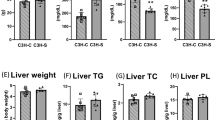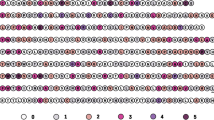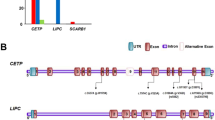Abstract
A reduction of high density lipoprotein cholesterol (HOC) is recognized as an important risk factor for coronary artery disease (CAD). We now show in approximately 1 in 20 males with proven atherosclerosis that an Asn291Ser mutation in the human lipoprotein lipase (LPL) gene is associated with significantly reduced HDL levels (P=0.001) and results in a significant decrease in LPL catalytic activity (P<0.0009). The relative frequency of this mutation increases in those patients with lower HDL cholesterol levels. In vitro mutagenesis and expression studies confirm that this change is associated with a significant reduction in LPL activity. Our data support the relationship between LPL activity and HDL–C levels, and suggest that a specific LPL mutation may be a factor in the development of atherosclerosis.
This is a preview of subscription content, access via your institution
Access options
Subscribe to this journal
Receive 12 print issues and online access
$209.00 per year
only $17.42 per issue
Buy this article
- Purchase on Springer Link
- Instant access to full article PDF
Prices may be subject to local taxes which are calculated during checkout
Similar content being viewed by others
References
Hobbs, H.H., Brown, M.S. & Goldstein, J.L. Molecular genetics of the LDL receptor gene in familial hypercholesterolemia. Hum. Mut. 1, 445–466 (1992).
Soria, L.F., Ludwig, E.H., Clarke, H.R.G., Vega, G.L., Grundy, S.M. & McCarthy, B.J. Association between a specific apolipoprotein B mutation and familial defective apolipoprotein B-100. Proc. natn Acad. Sci. U.S.A. 86, 587–591 (1989).
Brown, M.L. et al. Molecular basis of lipid transfer protein deficiency in a family with increased high-density lipoproteins. Nature 342, 448–451 (1989).
Rubin, E.M., Krauss, P.M., Spangler, E.A., Verstuft, G. & Clift, S.M. Inhibition of early atherogenesis in transgenic mice by human apolipoprotein A1. Nature 353, 265–266 (1991).
Gordon, T., Caselli, W.P., Hjortland, M.C., Kannel, W.B. & Dawber, T.R. High density lipoprotein as a protective factor agains coronary heart disease: the Framingham Study. Am. J. Med. 62, 707–714 (1977).
Tikkanen, M.J. & Nikkila, E.A. Post-heparin plasma lipoprotein and hepatic lipase are determinants of hypo and hyper-alphalipoproteinemia. J. Lipid Res. 30, 1117–1126 (1989).
Taskinen, M.R. & Nikkila, E.A. High density lipoprotein subfractions in relation to lipoprotein lipase activity of tissues in man — evidence for reciprocal regulation of HDL2 and HDL3 levels by lipoprotein lipase. Clin. Chim. Acta. 115, 63–71 (1981).
Brunzell, J.D. Familial lipoprotein lipase deficiency and other causes of the chylomicronemia syndrome. in The Metabolic Basis of Inherited Disease 6th edn (eds Scriver, C. R. & Sly, W.S.) 1168–1180 (McGraw-Hill, New York, 1989).
Ma, Y. et al. Increased frequency of an Asn291 Ser mutation in the human LPL gene in patients with Apo E2 deficiency (E2/2, E3/2 and E4/2) and hyperlipidemia including type III hyperlipoproteinemia. Circulation 88, 1–179 (1993).
Wion, K.L., Kirchgessner, T.G., Lusis, J., Schotz, M.C. & Lawn, R.M. Human lipoprotein lipase complementary DNA sequence. Science 235, 1638–1641 .(1987).
Roncaglioni, M.C. et al. Role of family history in patients with myocardial infarction. Circulation 85, 2065–2072 (1992).
Genest, J.J. Jr., et al. Familial lipoprotein disorders in patients with premature coronary artery disease. Circulation 85, 2025–2033 (1992).
Blades, B., Vega, G.L. & Grundy, S.M. Activities of lipoprotein lipase and hepatic triglyceride lipase in postheparin plasma of patients with low concentrations of HDL cholesterol. Art. Thromb. 138, 1227–1235 (1993).
Miller, N.E., Thelle, D.S., Forde, O.H. & Mops, O.D., Study: high-density lipoprotein and coronary heart disease: a prospective case-control study. Lancet 1, 965–968 (1977).
Garrison, R.J. et al. Obesity and lipoprotein cholesterol in the Framingham Offspring Study. Metabolism 29, 1053–1060 (1983).
Tanaka, N., Sakaguchi, S., Oshige, K., Niimura, T. & Kanehisa, T. Effect of chronic administration of propranalol on lipoprotein composition. Metabolism 25, 1071–1075 (1976).
Schauer, I., Schauer, U., Ruhling, K. & Theilmann, K. The effect of propranalol treatment on total cholesterol, HDL cholesterol, triglycerides, postheparin lipolytic activity and lecithin cholesterol acyltransferase in hypertensive individuals. Artery 8, 146–150 (1980).
Garrison, R.J. et al. Cigarette smoking and HDL cholesterol on fasting triglyceride, total cholesterol and HD-cholesterol in women.An. Heart J. 105, 417–421 (1983).
Chamberlain, J.C., Thorn, A., Oka, K., Galton, D.J. & Stocks, J. DNA polymorphisms at the lipoprotein lipase gene: associations in normal and hypertriglyceridaemic subjects. Atherosclerosis 79, 85–91 (1989).
Heizmann, C. et al. DNA polymorphism haplotypes of the human lipoprotein lipase gene: possible association with high density lipoprotein levels. Hum. Genet. 86, 578–584 (1991).
Antonarakis, S.E., Kazazian, H.H. & Orkin, S.H. DNA polymorphism and molecular pathology of the human globin gene cluster. Hum. Genet. 59, 1–14 (1985).
Ma, Y. et al. High frequency of mutations in the human lipoprotein lipase gene in pregnancy-induced chylomicronemia: possible association with apolipoprotein E2 isoform. J. Lipid Res. 35, 1066–1075 (1994).
Zilversmit, D.B. A proposal linking atherogenesis to the interaction of endothelial lipoprotein lipase with triglyceride-rich lipoproteins. Circ. Res. 33, 633–638 (1973).
Herttuala, S.Y. et al. Macrophages and smooth muscle cells express lipoprotein lipase in human and rabbit atherosclerotic lesions. Proc. natn. Acad. Sci. U.S.A. 88, 10143–10147 (1991).
Saxena, U., Klein, M.G., Vanni, T.M. & Goldberg, I.J. Lipoprotein lipase increases low density lipoprotein retention by subendothelial cell matrix. J. din. Invest. 89, 373–380 (1992).
Shimada, M. et al. Overexpression of human lipoprotein lipase in transgenic mice. J. biol. Chem. 268, 17924–17929 (1993).
Liu, M.S. et al. Alteration of lipid profiles in plasma of transgenic mice expressing human lipoprotein lipase. J. biol. Chem. 269, 11417–11424 (1994).
Tsutumi, K. et al. The novel compound NO-1886 increases lipoprotein lipase activity with resulting elevation of high density and long-term administration inhibits atherogenesis in the coronary arteries of rats with experimental atherosclerosis. J. din. Invest. 92, 411–417 (1993).
Wilson, D.E. et al. Phenotypic expression of heterzygous lipoprotein lipase deficiency in the extended pedigree of a proband homozygous for a missense mutation. J. din. Invest. 86, 735–750 (1990).
Miesenbock, G. et al. Heterozygous lipoprotein lipase deficiency due to a missense mutation as the cause of impaired triglyceride tolerance with mutliple lipoprotein abnormalities. J. clin. Invest. 91, 448–455 (1993).
Verschuren, W.M.M. et al. Cardiovascular risk factors in the Netherlands. Neth. J. Cardiol. 4, 205–210 (1993).
Allain, C.C., Poon, L.S., Chan, C.S.G., Richmond, W. & Fu, P.C. Enzymatic determination of total serum cholesterol. Clin. Chem. 20, 470–475 (1974).
Buccolo, G. & David, H. Quantitative determination of serum triglycerides by the use of enzymes. Clin. Chem. 19, 476–482 (1973).
Warnick, G.R. & Albers, J.J. Heparin-Mn2+ quantification of high density lipoprotein cholesterol: an ultrafiltration procedure for lipidemic samples. Clin. Chem. 24, 900–904 (1978).
Babirak, S.P., Iverius, P.H., Fujomoto, W.Y. & Brunzell, J.D. Detection and characterization of heterozygous state for lipoprotein lipase deficiency. Arteriosclerosis 9, 326–334 (1989).
Iverius, P.H. & Brunzell, J.D. Human adipose tissue lipoiprotein lipase: changes with feeding and relationship to postheparin plasma enzyme. Am. J. Physiol. 249, E107–E114 (1985).
Liu, M.S., Ma, Y., Hayden, M.R. & Brunzell, J.D. Mapping of the epitope on lipoprotein lipase recognized by a monoclonal antibody (5D2) which inhibits lipase activity. Biophys. Acta. 128, 113–115 (1992).
Tips: an efficient salt-chloroform extraction of DNA from blood and tissues. Trends Genet. 5, 391 (1989).
Bruin, T., Reymer, P.W.A., Groenemeyer, B.E., Talmud, P.J. & Kastelein, J.J.P. Hindlll polymorphism in the LPL-gene detected by PCR. Nud. Acids Res. 19, 6346 (1992).
Johnson, J.P., Nishina, P.M. & Naggert, J.K. PCR assay for a polymorhic Pvull site in the lipoprotein lipase gene. Nud. Acids Res. 18, 7469 (1992).
Ma, Y. et al. Two naturally occurring mutations at the first and second base of codon Asp156 in the proposed catalytic triad of human lipoprotein lipase — in vivo evidence that Asp156 is essential for catalysis. J. biol. Chem. 267, 1918–1923 (1992).
Author information
Authors and Affiliations
Rights and permissions
About this article
Cite this article
Reymer, P., Gagné, E., Groenemeyer, B. et al. A lipoprotein lipase mutation (Asn291Ser) is associated with reduced HDL cholesterol levels in premature atherosclerosis. Nat Genet 10, 28–34 (1995). https://doi.org/10.1038/ng0595-28
Received:
Accepted:
Issue Date:
DOI: https://doi.org/10.1038/ng0595-28
This article is cited by
-
Identifying gene–gene interactions that are highly associated with four quantitative lipid traits across multiple cohorts
Human Genetics (2017)
-
When high is low: Raising low levels of high-density lipoprotein cholesterol
Current Cardiology Reports (2008)
-
Increased Postprandial Triglyceride‐Rich Lipoprotein Levels in Elderly Survivors of Myocardial Infarction
Lipids (2008)
-
Postprandial lipemia and coronary risk
Current Atherosclerosis Reports (2000)
-
Mutations in ABC1 in Tangier disease and familial high-density lipoprotein deficiency
Nature Genetics (1999)



